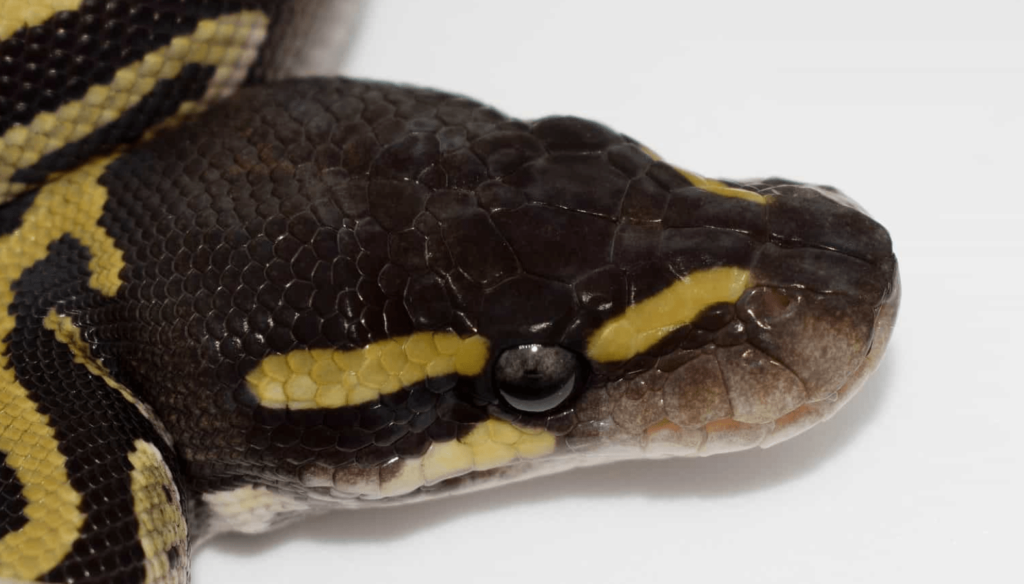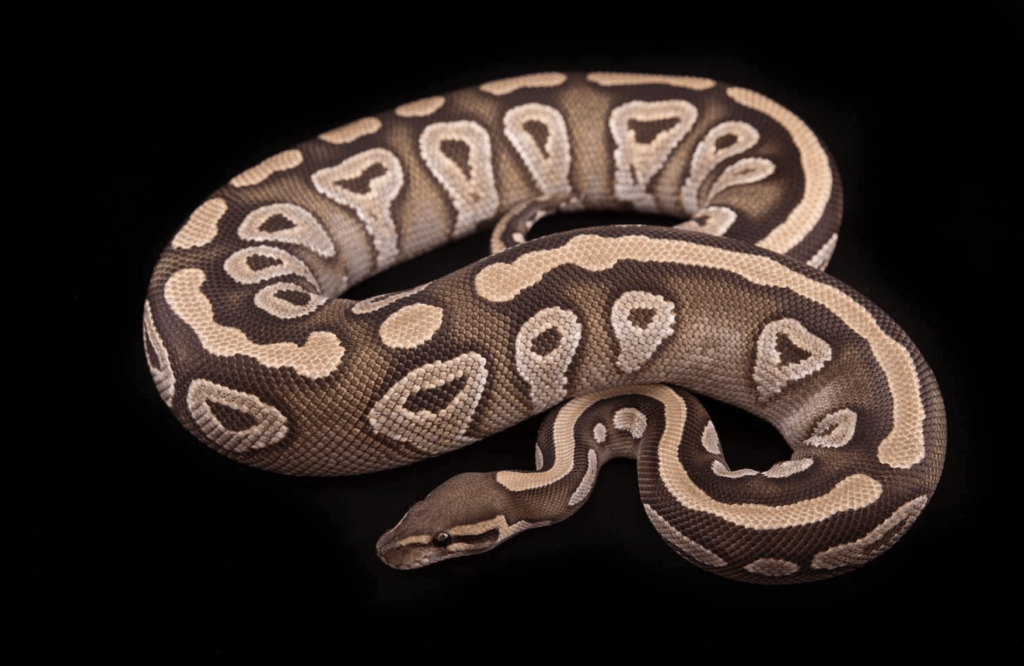The Mojave ball python is the distinctive common base morph of the ball python and is named after the Mojave Desert. The breed was first created at The Snake Keeper, Inc. in 2000 by Dan and Colette Sutherland, breeders from Utah. The form of this snake varies greatly depending on the Mojave’s appearance. Instead of the general striped body pattern? The “alien head” found on most morphs, Mojave morphs, has markings resembling a giant round bullseye. The spots are usually dark brown or very black. and may be tan, gold, or light brown in color. Mojave pythons are often highly contrasting snakes. It comes in shades of grey, dark brown, and gold, although the exact color scheme may vary. Recently, a designer Morph was created that combines Mojave Morph with additional features. Among them are Firefly Mojave, Super Mojave, and Pastel Mojave.
Table of Contents
Mojave Ball Python Facts
- To date, only one Mojave ball python has been found in the wild. This means all existing Mojave ball pythons are likely this snake’s descendants! Base morphs like the Mojave can technically occur in the wild naturally, but this is extremely rare.
- Based in Utah, the breeders at The Snake Keeper, Inc. named the Mojave morph after the nearby Mojave Desert.
- The Super Mojave morph was developed in 2003 by breeding two Mojave ball pythons together.
- Reptile breeders often combine the Mojave morph with other traits to pass on its striking keyhole/bullseye body pattern.
- While the majority of the Mojave morph’s body is bold and quite colorful, its belly is typically solid white with little to no markings.
Where to Find Mojave Ball Pythons
There are many places in western and central Africa where wild ball pythons can be found. It likes areas with open grassland and some wood, such as savannahs, grasslands, and sometimes near water sources. Large populations of this species occur in Senegal, Ghana and Nigeria. The Mojave morph is especially noteworthy because it has been seen in the wild, however, only one has been confirmed. Many reptile breeders believe that this snake is the ancestor of all modern Mojave pythons. Basic changes, such as the Mojave, can sometimes be found in the wild. But it’s very difficult to find. and there have been only a handful of confirmed sightings. Today, Mojave ball python are widely available online and at reptile exhibitions around the world. Since then Many horse breeders who established their own Mojave breed sold it. Prices range from $80 to $150. They have been around for over 20 years and are one of the cheapest morphs available. Created in 2000, it is very popular among lovers of all kinds of reptiles. Despite being one of the first basic animals to become popular in the exotic pet industry.
Mojave Ball Python Scientific Name

The ball python’s scientific name is Python regius, which means “royal python.” It has no subspecies and is the smallest species in the python family. All ball pythons belong to the same species. Therefore, they have the same scientific name and classification. Interestingly, the Ball Python’s royal name comes from a legend in which ancient Egyptian royalty adorned their bodies with live snakes in a bold display of wealth and status. Cleopatra herself may have “worn” a bracelet made from a baby python on her wrist.
Mojave Ball Python Population and Conservation Status
Since 2012, ball pythons have been classified as Near Threatened on the IUCN Red List. This indicates a decline in the species’ population in their natural range in Africa. However, they do not face any threat of extinction in immediately housing degradation Human hunting for food And the exotic pet trade is the main reason for the python’s status as a near-threatened species. In particular, the rapid expansion of Africa’s agricultural economy has significantly limited the ball python’s habitat. Deforestation by other industries is also an important factor.
How to Identify Mojave Ball Python: Appearance and Description

The Mojave morph is one of the most easily recognized because of its very distinctive body markings. The exact color may vary greatly. The “Mojave pattern” is a distinctive feature common to all Mojave pythons. They look like large, round spots with a small dark spot in the center. The spots are usually light brown, white, yellow, or tan. The stem has small dark brown or black spots. It’s like a keyhole or a target. In addition to their distinctive appearance, Mojave morphs are characterized by a number of important characteristics. A high-contrast style with almost no redness except on the top of the head. It is perhaps the most striking form. The bright yellow eye stripes also provide a striking contrast to the dark brown skull. Additionally, most Mojave pythons have pure white bellies. In short, these key traits define the Mojave ball python:
- “Mojave pattern” that resembles lots of large, round bullseyes with dark brown centers extending down the snake’s entire body
- High-contrast patterning that can vary in color but typically has mainly gold, gray, and dark brown tones
- Very bright yellow eye stripes in contrast to its mostly dark brown head
- Very little blushing aside from the pale spot atop the center of the head
- Solid white belly with no markings
Mojave Ball Python Evolution and History
Mojave Morph is a morph that shares a single dominant gene. Created in 2000 by Dan and Collette Sutherland of The Snake Keeper, Inc. in Utah, the name of this Morph was inspired by the Mojave Desert. TSK also makes popular morphs such as Tri Stripe and Inca. Reptile breeders have combined various characteristics of the Mojave morph to create varieties such as the Pastel Mojave, Cinnamon Mojave, and Mojave Pied. Additionally, in 2003, breeder Wes Harris bred the Mojave python. Two Jaws are joined together to create the Super Mojave Morph. Over the years New features are introduced. Thousands have hit the market, but Mojave Morph is still very popular. Reptile breeders who want to pass on the Mojave pattern to their children and grandchildren. This breed is liked by “cleaners” for its unique pattern, low red color, bright eye stripe, and striking appearance.
Mojave Ball Python: How Dangerous Are They?
No matter what form they take. All ball pythons tend to be shy and gentle. As one of the smallest pythons, it is nonvenomous and can grow up to 5 feet long. It is believed to not pose a threat to humans. In fact Ball pythons have become one of the most popular pet snakes in the world. Because of its small size and friendly personality. What’s interesting is the ball python’s unique defense mechanism. which rolls into a small ball Therefore is the origin of the name of this breed. In general, Pythons will run away or curl up to make themselves appear smaller when they feel threatened, but many other snakes bite or raise their bodies into more dangerous positions to frighten predators. In addition to warm water, soap, and a bandage, A python bite may require minimal medical attention. A python bite is very weak and not very dangerous to humans. Because it doesn’t really have fangs. and instead had small, delicate, and thin teeth.
Mojave Ball Python Behavior and Humans
Ball pythons are one of the most beloved stars of the reptile world for several main reasons, as briefly discussed earlier. Their wonderfully gentle yet curious and flexible natures make them They are well cared for and are fun companions. All ball pythons are the same breed and therefore have very similar personalities. They also require the same maintenance. The main feature that makes ball python popular among people is that It is small and easy to control. Ball pythons are much smaller. They can be up to 5 feet long compared to other python species. They can grow to be over 20 feet long and weigh over 100 pounds. They can survive in cages as small as 50 to 60 gallons and maintain excellent health in captivity. Although they became popular as pets in the mid-1990s, ball pythons have become one of the most widely kept pet reptiles in the world. Since 1995, more developments have occurred. Nearly 4,000 new breeds have been produced, and hundreds of breeders continue to produce more.